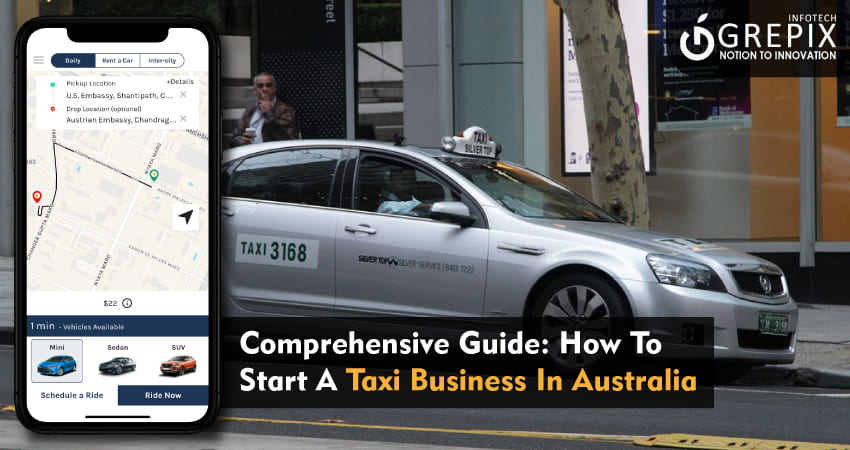Comprehensive Guide: How To Start A Taxi Business In Australia
Establishing a taxi business in Australia is a promising endeavor because of the nation's strong economy, busy cities, and a constant stream of tourists. But to successfully navigate the process, one needs to have a solid grasp of the industry, plan strategically, and follow certain rules. The essential procedures and factors to take into account when starting a successful taxi company in Australia are described in this thorough guide.
Launching a taxi business in Australia is a promising venture, thanks to the country’s thriving economy, bustling urban centers, and continuous flow of tourists. This comprehensive guide outlines critical steps for establishing a successful taxi company, emphasizing the importance of market research, strategic business planning, regulatory compliance, and effective vehicle management. It covers everything from identifying your target market and choosing the right business model to securing funding and acquiring vehicles. It also discusses the potential for growth and the importance of continuous improvement to sustain success. For those looking to enter the taxi industry with a technological edge, Grepix Infotech offers top-tier taxi app development solutions. Their user-friendly and secure app, akin to Uber and Lyft, is complemented by a customizable Uber clone script, streamlining the launch of online taxi booking services.
How To Start Your Business In Australia
1. Research And Market Analysis
- Understanding the Market: It is imperative to carry out a thorough market analysis before entering the taxi industry. This entails determining the demand for taxi services in various locations, locating possible rivals, and evaluating the advantages and disadvantages of each. Demand is greatly impacted by several factors, including business districts, tourist attractions, population density, and the availability of public transportation.
- Customer Segmentation: It's critical to determine who your target customer is. Potential clients could include people in need of specialized transportation services as well as frequent commuters, vacationers, and business travelers. It will be easier to properly customize your services if you are aware of the unique requirements and preferences of these markets.
2. Business Planning
- Business Model: Select a business plan that aligns with your goals and the demands of the market. You have the option of using a ridesharing model, a luxury car service, or a traditional taxi service. Every model has a different approach to pricing, marketing, and operations.
- Financial Planning: It's imperative to have a thorough financial plan. This includes projecting operating costs, starting costs (like buying or leasing a car, getting a license, and getting insurance), and revenue. Think about the pricing plan that would allow your service to be both profitable and competitive.
- Licensing and Regulations: State-specific laws and licensing requirements apply to taxi companies operating in Australia. These could entail getting a license to operate a taxi, having your car inspected, and becoming accredited as a driver. Learn about the rules set forth by the local transportation authorities and the Australian Taxi Industry Association.
3. Securing Funding
- Capital Requirements: Determine the total amount of money required to start your business, taking into account the cost of buying a car, licensing, insurance, and marketing.
- Funding Options: Look into a range of funding sources, including investor searches, business loans, and personal savings. Seeking funding from banks or investors requires presenting a strong business plan.
4. Vehicle Acquisition And Preparation
- Choosing the Right Vehicles: Pick automobiles that fit your target customer segments, are dependable, fuel-efficient, and compliant with regulations. Take into account aspects like comfort, environmental impact, and accessibility for passengers with disabilities.
- Branding: Your cars serve as a mobile billboard for your company in addition to being a means of transportation. Take into consideration professional branding that is noticeable and recognizable and reflects the identity of your company.
5. Licensing And Compliance
- Operator’s License: Submit an application to the appropriate state agency for an operator's license. You must demonstrate your ability to pay, your business sense, and your compliance with safety and legal requirements during this process.
- Vehicle Registration And Insurance: Verify that all of your automobiles have the appropriate insurance and registration. It is imperative to have comprehensive insurance that covers drivers, passengers, and third-party liabilities.
- Driver Recruitment And Training: Find competent drivers who are accredited and who value customer service as much as you do. It is advantageous to put in place a strict training program on safe driving techniques, customer service, and local knowledge.
6. Technology And Systems
- Booking And Dispatch System: Invest in a dependable system that enables simple booking via a variety of channels (phone, internet, app) and effective ride dispatching. Features for real-time tracking and communication improve both operational effectiveness and customer experience.
- Payment Solutions: To accommodate customer preferences, provide a variety of payment methods, such as cash, credit/debit cards, and mobile payments. Payment systems must be reliable and secure to earn the trust and satisfaction of customers.
7. Marketing And Branding
- Brand Identity: Create a compelling brand identity that appeals to your intended audience. A distinctive name, logo, and value proposition are all part of this.
- Marketing Strategies: Use a combination of offline and internet marketing techniques. Employ local advertising, SEO, and social media to connect with prospective clients. Business can also be boosted by alliances with nearby companies, lodging facilities, and tourist destinations.
- Customer Experience: To set your brand apart, concentrate on providing outstanding customer service. Easy booking, hygiene, security precautions, and polite drivers are just a few of the attributes that greatly increase customer satisfaction and retention.
8. Operations Management
- Monitoring And Optimization: Keep an eye on operational data like ride requests, fulfillment rates, client satisfaction, and financial results regularly. Utilize this information to enhance service quality, streamline operations, and make necessary adjustments to pricing or marketing plans.
- Sustainability Practices: To lessen your influence on the environment and draw in eco-aware clients, think about introducing sustainable practices, like driving electric or hybrid cars.
9. Expansion And Scaling
- Growth Strategies: After you're established, think about broadening your service area, getting more cars, or changing up the services you offer (luxury transportation, parcel delivery, etc.). Growth depends on forming strategic alliances and using technology to increase scalability.
- Continuous Improvement: Keep up with changes in the market, technology, and consumer preferences. Long-term success requires constant enhancement of service offerings, operational effectiveness, and customer experience.
Conclusion
Starting a taxi service In Australia, is a difficult but worthwhile venture. A well-thought-out plan, market knowledge, regulatory compliance, efficient use of technology, and a dedication to providing excellent customer service are all necessary for success. In the competitive and dynamic transport sector of Australia, your taxi business can prosper with careful planning and execution.
Grepix Infotech is a prominent taxi app development company that provides excellent solutions for starting a taxi company. Similar to industry titans Uber and Lyft, our taxi app is well-liked by many taxi companies due to its user-friendliness and security. With our ready-to-use Uber clone script, you can effectively launch your online taxi booking business. Our committed team will begin the setup and customization of the app as soon as it is acquired, adding your company's name and logo, matching the app's color scheme to your logo, and creating a unified brand experience.
In addition to being white-labeled, our product is completely customizable to satisfy the particular needs of taxi service providers as well as commuters. To meet the various demands of the taxi industry, the taxi script provides a flexible web platform that makes booking options simple for clients and maximizes operational effectiveness for service providers. Want to use cutting-edge Uber clone software to transform your taxi business? Select our offering for a quick and significant market launch.







